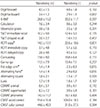Abstract
Background
Wandering represents one of a major problem occurring in patients with Alzheimer's disease (AD). To find the disproportionate neuropsychological deficit and behavioral psychological symptoms in dementia (BPSD) of AD patients with wandering compared to AD patients without wandering, this study examined the set of neuropsychological tests and caregiver-administered neuropsychiatric inventory (CGA-NPI).
Methods
Psychotropic-naïve (drug-naïve) probable AD patients with wandering (64) and without wondering (278) were assessed with the Seoul Neuropsychological Screening Battery, which included measures of memory, intelligence, and executive functioning.
Results
Patients with wandering had lower scores in the Rey-Osterrieth Complex Figure copy, Fist-edge-palm, Alternating hand movement tests compared to patients without wandering. The degree of wandering in AD patients was significantly related with CGA-NPI subdomains of aggression, disinhibition, depression, and delusions.
Conclusion
This study showed that 1) AD patients with wandering have disproportionately cognitive deficit suggesting frontal and right parietal dysfunctions, 2) wanderings are related with specific BPSD. Considering these results, AD patients with wandering may have specific neuronal anatomic substrates related with pathology of Alzheimer.
Figures and Tables
References
1. Hope T, Tilling KM, Gedling K, Keene JM, Cooper SD. The structure of wandering in dementia. Int J Geriatr Psychiatry. 1994; 9:149–155.

3. Algase DL, Kupferschmid B, Beel-Bates CA, Beattie ER. Estimates of stability of daily wandering behavior among cognitively impaired long-term care residents. Nurs Res. 1997; 46:172–178.

4. Cooper JK, Mungas D, Weiler PG. Relation of cognitive status and abnormal behaviors in Alzheimer's disease. J Am Geriatr Soc. 1990; 38:867–870.

5. Rowe MA, Glover JC. Antecedents, descriptions and consequences of wandering in cognitively-impaired adults and the Safe Return (SR) program. Am J Alzheimers Dis Other Demen. 2001; 16:344–352.

6. Choi SH, Na DL, Kwon HM, Yoon SJ, Jeong JH, Ha CK. The Korean version of the neuropsychiatric inventory: a scoring tool for neuropsychiatric disturbance in dementia patients. J Korean Med Sci. 2000; 15:609–615.

7. Ku HM, Kim JH, Kwon EJ, Kim SH, Lee HS, Ko HJ, et al. A study on the reliability and validity of Seoul-instrumental activities of daily living (S-IADL). J Korean Neuropsychiatr Assoc. 2004; 43:189–199.

8. Ahn HJ, Chin J, Park A, Lee BH, Suh MK, Seo SW, et al. Seoul Neuro-psychological Screening Battery-dementia version (SNSB-D): a useful tool for assessing and monitoring cognitive impairments in dementia patients. J Korean Med Sci. 2010; 25:1071–1076.

9. Cohen-Mansfield J, Werner P, Marx MS. The social environment of the agitated nursing home resident. Int J Geriatr Psychiatry. 1992; 7:789–798.

10. Algase DL, Struble L. Wandering: what, why how?. In : Buckwalter K, editor. Geriatric mental health nursing: current and future challenges. Thorofare, NJ: SLACK Incorporated;1992. p. 61–74.

11. Lai CK, Arthur DG. Wandering behaviour in people with dementia [Review]. J Adv Nurs. 2003; 44:173–182.

12. Kavcic V, Duffy CJ. Attentional dynamics and visual perception: mechanisms of spatial disorientation in Alzheimer's disease. Brain. 2003; 126:1173–1181.

13. Tetewsky SJ, Duffy CJ. Visual loss and getting lost in Alzheimer's disease. Neurology. 1999; 52:958–965.

14. Rolland Y, Payoux P, Lauwers-Cances V, Voisin T, Esquerre JP, Vellas B. A SPECT study of wandering behavior in Alzheimer's disease. Int J Geriatr Psychiatry. 2005; 20:816–820.

15. Meguro K, Yamaguchi S, Yamazaki H, Itoh M, Yamaguchi T, Matsui H, et al. Cortical glucose metabolism in psychiatric wandering patients with vascular dementia. Psychiatry Res. 1996; 67:71–80.
16. Chiu YC, Algase D, Whall A, Liang J, Liu HC, Lin KN, et al. Getting lost: directed attention and executive functions in early Alzheimer's disease patients. Dement Geriatr Cogn Disord. 2004; 17:174–180.
17. Phillips VL, Diwan S. The incremental effect of dementia-related problem behaviors on the time to nursing home placement in poor, frail, demented older people. J Am Geriatr Soc. 2003; 51:188–193.

18. Holtzer R, Tang MX, Devanand DP, Albert SM, Wegesin DJ, Marder K, et al. Psychopathological features in Alzheimer's disease: course and relationship with cognitive status. J Am Geriatr Soc. 2003; 51:953–960.

19. Hope T, Keene J, McShane RH, Fairburn CG, Gedling K, Jacoby R. Wandering in dementia: a longitudinal study. Int Psychogeriatr. 2001; 13:137–147.

20. Song JA, Lim YM, Hong GR. Wandering behaviour of persons with dementia in Korea: investigation of related factors. Aging Ment Health. 2008; 12:366–373.

22. Chan RC, Rao H, Chen EE, Ye B, Zhang C. The neural basis of motor sequencing: an fMRI study of healthy subjects. Neurosci Lett. 2006; 398(3):189–194.

23. Lachs MS, Becker M, Siegal AP, Miller RL, Tinetti ME. Delusions and behavioral disturbances in cognitively impaired elderly persons. J Am Geriatr Soc. 1992; 40:768–773.

24. Kiely DK, Morris JN, Algase DL. Resident characteristics associated with wandering in nursing homes. Int J Geriatr Psychiatry. 2000; 15:1013–1020.





 PDF
PDF ePub
ePub Citation
Citation Print
Print





 XML Download
XML Download